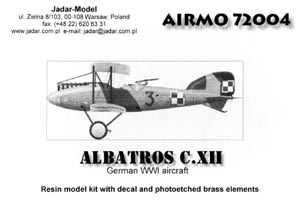Airmo 1/72 Albatros C.XII |  | Basic Overview I don't have much on this plane. Basically, the Albatros C.XII was designed as a successor to the C.X. It entered service in the Autumn of 1917, and was in widespread use until the end of the war. And judging from the decals, some post-war usage in Poland.  The Kit The Kit
When it comes to resin kits, Eastern Europe is definitely the place to look. Upon opening this box I was greeted by some of the nicest cast resin parts I have seen. Coupled with an extensive photoetch fret, this kit looks very impressive. The resin parts are crisp and warp-free, no mean feat considering that the top wing is molded as one piece. The instructions consist of three pieces of paper, two of which are devoted to colors and markings. The exploded view drawings are more than sufficient to place all the assorted detail bits. The decal  sheet provides markings for several Polish and one German aircraft. sheet provides markings for several Polish and one German aircraft. Looking closer, building this kit is definitely not for the beginner. The interior is made up almost entirely from photoetch, so be prepared for a lot of bending and folding. Once finished, though, it will almost be a shame to close up the fuselage halves. The resin engine and exhaust stack is also nicely detailed and again will mostly be hidden once the fuselage is together.  Assembly of the main pieces shows just how much thought the master makers put into this kit. The fuselage halves have large mating surfaces, with the rear fuselage actually solid and incorporating a mating pin. The lower wings are also pegged rather than flush fit, which adds strength. The upper wing is attached with resin struts, and it is here that perhaps the modeler will choose to replace those with plastic or metal replacements for additional strength. The landing gear struts are robust, though, and should pose no problem in supporting the finished model. About the only thing missing from the instructions is a rigging diagram. Assembly of the main pieces shows just how much thought the master makers put into this kit. The fuselage halves have large mating surfaces, with the rear fuselage actually solid and incorporating a mating pin. The lower wings are also pegged rather than flush fit, which adds strength. The upper wing is attached with resin struts, and it is here that perhaps the modeler will choose to replace those with plastic or metal replacements for additional strength. The landing gear struts are robust, though, and should pose no problem in supporting the finished model. About the only thing missing from the instructions is a rigging diagram.
 The marking choices include three Polish C.XIIs and one German one. All three Polish examples are finished with dark green on the upper flying surfaces, with light blue on the lower. The fuselage was left in unpainted varnished wood. All three are from 1919, but no unit information is included. The German example is painted in a similar fashion to the Polish aircraft and dates from the spring of 1918. The decals themselves are well printed by Techmod and should pose no problems. The marking choices include three Polish C.XIIs and one German one. All three Polish examples are finished with dark green on the upper flying surfaces, with light blue on the lower. The fuselage was left in unpainted varnished wood. All three are from 1919, but no unit information is included. The German example is painted in a similar fashion to the Polish aircraft and dates from the spring of 1918. The decals themselves are well printed by Techmod and should pose no problems.
Conclusion This is a beautiful resin kit of an interesting German aircraft. If you are into WWI subjects and have done a couple resin kits already, this one should pose no problems and will result in an attractive model when finished. | 








|
